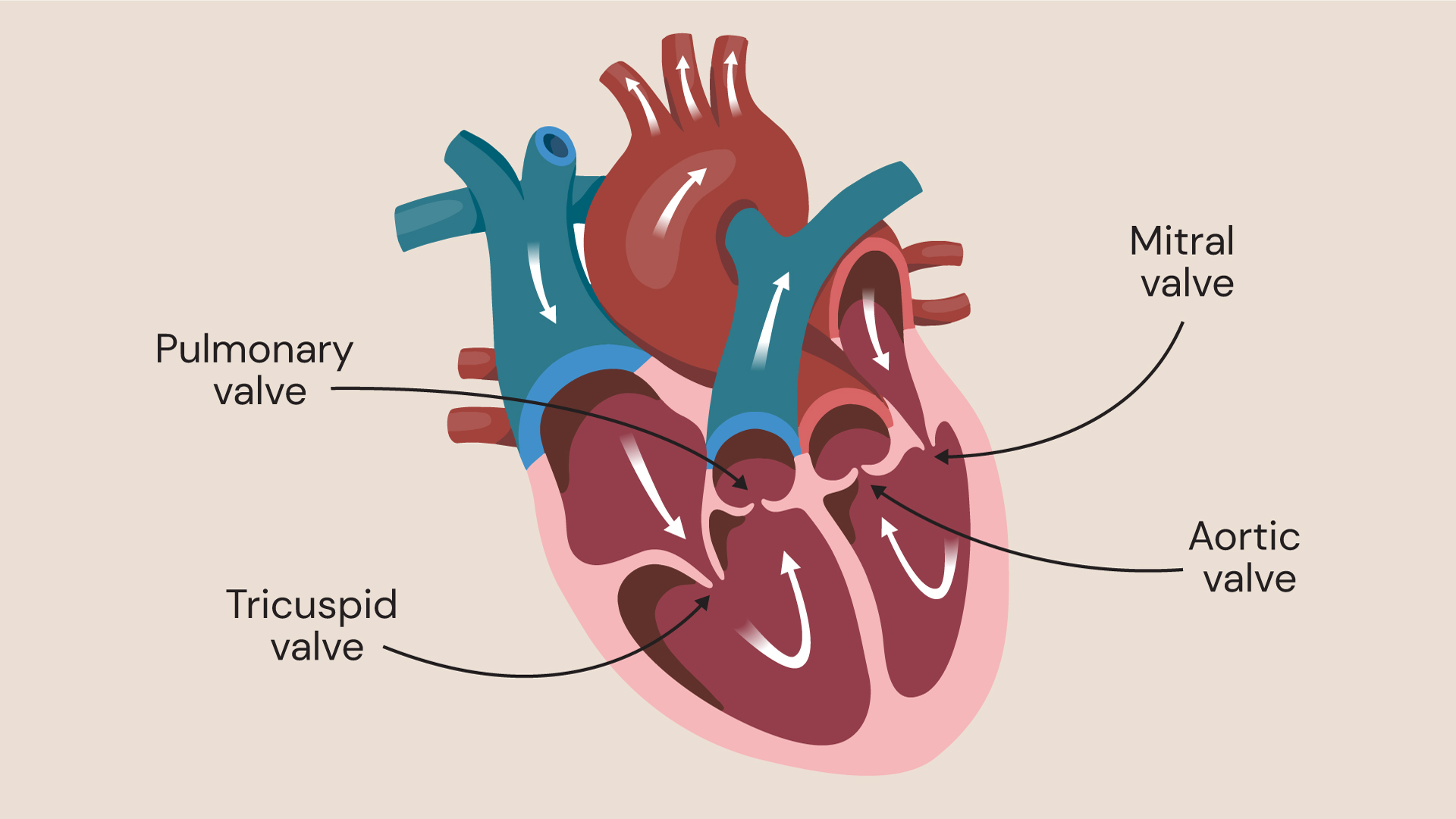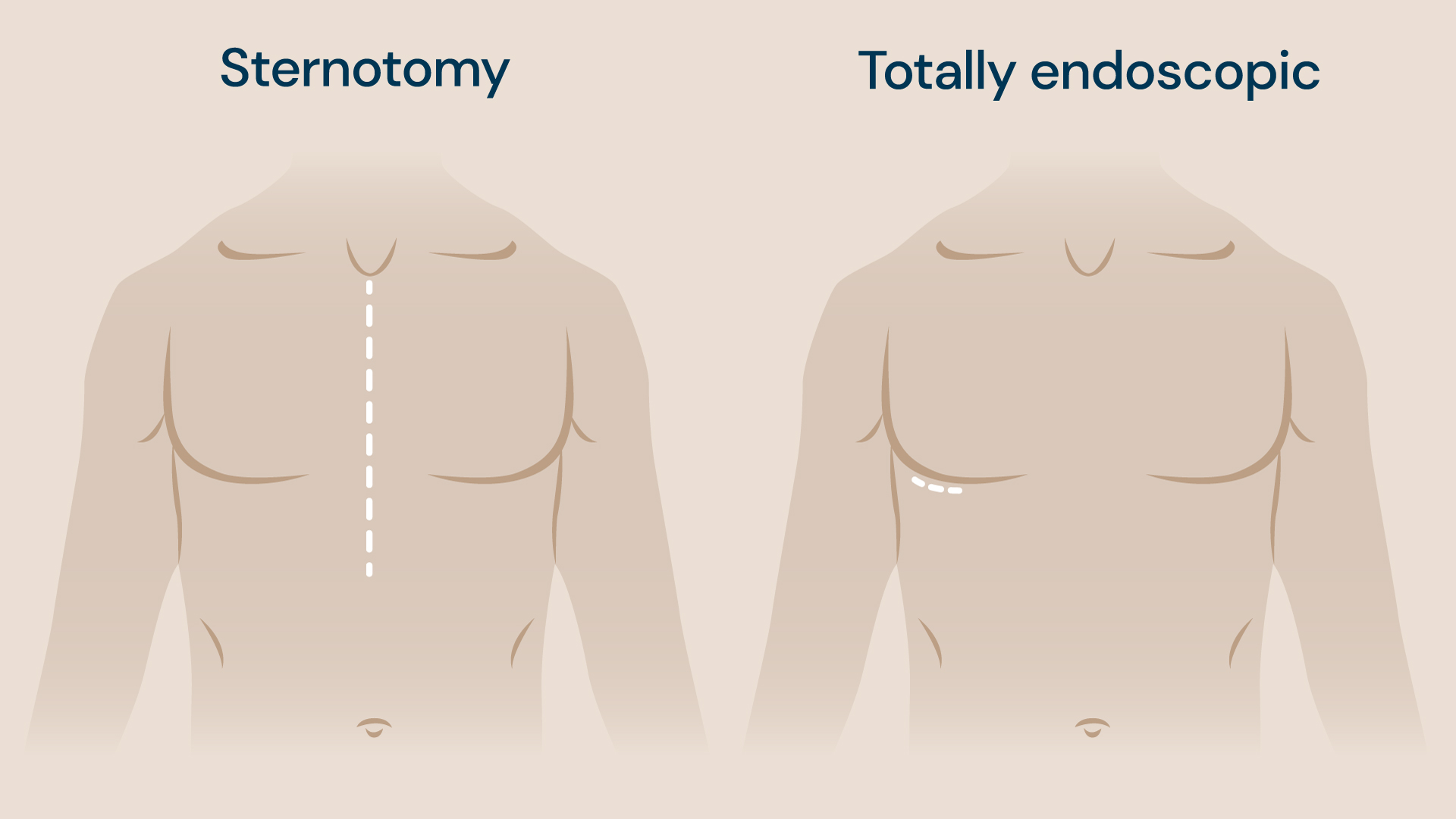Our consultants at Royal Brompton and Harefield hospitals have developed a UK-first keyhole surgery procedure to repair and replace heart valves. The procedure reduces scarring and improves recovery time in patients from 3 months to 3 weeks, when compared to conventional open heart surgery.
The evolution of open heart surgery
Your heart has four valves (tricuspid, mitral, aortic and pulmonary) and when these need to be repaired or replaced, the approach most widely used is open heart surgery (also known as sternotomy).

During this procedure, an incision – usually 20-30cm long – is made in the chest. The breastbone is then separated to access the heart and blood vessels for treatment. The surgery is performed with the surgeon looking through the incision and it usually takes around 4 hours to complete, before the incision is stitched up to heal.
Recovery after open heart surgery takes 3-4 months as it’s not only the incision that needs to heal, but also the breastbone and chest muscles which were separated during the surgery. Internally, the valve must also heal after it has been repaired or replaced. Recovery from the incision is painful for patients, especially when it comes to breathing due to the associated movement of the chest.
Moving away from open heart surgery and to a less invasive solution is a process our consultants have been working on since 2010, leading several innovations in the field of valve repair and replacement. This led to the development of a new keyhole technique.
This procedure, first performed in the UK by Mr Bahrami and his team in 2021, uses footage from 3D cameras during surgery, combined with 3D glasses, to operate. “We have performed this procedure over 1,000 times, enabling us to provide our patients with gold-standard results,” says Mr Bahrami.
Keyhole heart surgery with 3D technology
Keyhole surgery (also called minimally invasive surgery or endoscopic surgery) is surgery carried out through small incisions in the chest. It relies on the use of a camera which projects images onto a screen to show the surgeon the inside of the incision, so that they can carry out the procedure.
In keyhole valve replacement and repair procedures, two main incisions are made – a small one in the side of your chest for the 3D camera to be inserted, and one along the edge of the nipple around 2.5cm in size.
The incision at the edge of the nipple is the hole through which the surgeon will perform the valve replacement or repair, using longer instruments specifically designed for minimal access. There is also another very small incision made for a drain to be inserted.
The keyhole valve surgery takes around 4.5 to 5 hours to complete, which is between 30 to 60 minutes longer than standard open heart surgery. However, these extra minutes taken during surgery to perform the delicate minimally invasive procedure is what brings patient recovery down from 3 months to 3 weeks.
As the surgeon doesn’t need to open the ribs or breastbone, or move chest muscles aside to access the heart, this greatly reduces recovery time. Mr Bahrami explains, “the whole purpose is not to make the operation shorter than open heart surgery – it’s to deliver a much-improved recovery period for our patients.”
Most patients are discharged from hospital after around 4 days, and are back to their usual daily activities in just 3 weeks. In fact, some of Mr Bahrami’s patients have been walking 15,000 steps a day and are back to driving just 2 weeks after their procedures. This would normally take 3 months with open heart surgery.
We are proud to have pioneered this technique at Royal Brompton and Harefield hospitals, and to have had our expertise in the field recognised by winning the LaingBuisson Award for ‘Innovation in Health Tech’ in November 2023.
Is open heart surgery safer than keyhole surgery?
Over the last 5 years, Mr Bahrami and his team at Royal Brompton and Harefield hospitals have participated in the first ever trial to help prove the benefits of keyhole heart valve surgery. The research compared the results of standard open heart surgery with minimal access procedures in mitral valve surgery, looking at several factors including rate of infection and average length of hospital stay.
The Journal of the American Medical Association (JAMA) published a study based on this research in April 2023 which demonstrated that the repair rate is the same across open heart and minimal access procedures, including keyhole surgery. Keyhole surgery is therefore just as safe as open heart surgery but with a significantly improved recovery time.
Mr Bahrami and his team have a particularly impressive track record in addition to this. In rare cases when patients have minimally invasive or keyhole surgery, complications can lead to the operating team needing to convert to open heart surgery to complete the procedure and save the patient’s life.
Having performed keyhole heart valve replacement and repair procedures over 1,000 times, Mr Bahrami has had no instances on converting to open heart surgery, and has completed every single procedure as planned.

Open heart surgery versus keyhole heart surgery
Suitability for keyhole valve surgery
Although there’s no age limitation for patients seeking keyhole valve repair or replacement, you will need a CT scan beforehand to determine your suitability and to ensure that minimally invasive surgery is a good option for you.
Patients with moderate aortic leak – where blood leaks back into the heart – are unsuitable for keyhole valve repair or replacement, but patients with mild aortic leak are often accepted by our surgical team for treatment.
Thorough checks before your surgery help our specialists to ensure that you will have as good a result as possible. If the pre-surgery checks suggest that keyhole surgery isn’t your best option, then you may be recommended for valve repair or replacement with open heart surgery instead.
Get in touch
To learn more about keyhole heart surgery for valve repair or replacement, please get in touch with our customer services team.
Related content
-
Heart valve repair or replacement
Heart valve surgery can repair or replace a damaged valve.
-
Aortic disease
Aortic stenosis is a narrowing of the aortic valve opening, restricting blood flow to the aorta.
-
Transcatheter aortic valve implantation (TAVI)
TAVI is a minimally invasive procedure where a new aortic valve is inserted into your heart.
